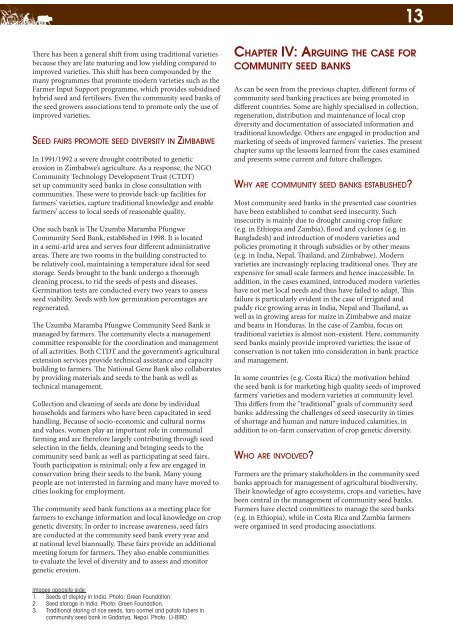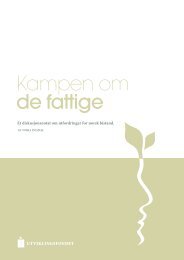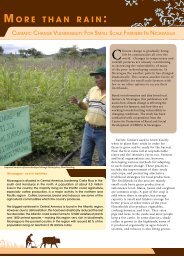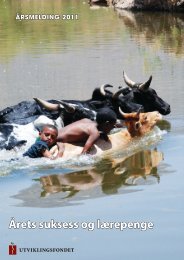Banking for the future: - Third World Network
Banking for the future: - Third World Network
Banking for the future: - Third World Network
- No tags were found...
Create successful ePaper yourself
Turn your PDF publications into a flip-book with our unique Google optimized e-Paper software.
13There has been a general shift from using traditional varietiesbecause <strong>the</strong>y are late maturing and low yielding compared toimproved varieties. This shift has been compounded by <strong>the</strong>many programmes that promote modern varieties such as <strong>the</strong>Farmer Input Support programme, which provides subsidisedhybrid seed and fertilisers. Even <strong>the</strong> community seed banks of<strong>the</strong> seed growers associations tend to promote only <strong>the</strong> use ofimproved varieties.Seed fairs promote seed diversity in ZimbabweIn 1991/1992 a severe drought contributed to geneticerosion in Zimbabwe’s agriculture. As a response, <strong>the</strong> NGOCommunity Technology Development Trust (CTDT)set up community seed banks in close consultation withcommunities. These were to provide back-up facilities <strong>for</strong>farmers’ varieties, capture traditional knowledge and enablefarmers’ access to local seeds of reasonable quality.One such bank is The Uzumba Maramba PfungweCommunity Seed Bank, established in 1998. It is locatedin a semi-arid area and serves four different administrativeareas. There are two rooms in <strong>the</strong> building constructed tobe relatively cool, maintaining a temperature ideal <strong>for</strong> seedstorage. Seeds brought to <strong>the</strong> bank undergo a thoroughcleaning process, to rid <strong>the</strong> seeds of pests and diseases.Germination tests are conducted every two years to assessseed viability. Seeds with low germination percentages areregenerated.The Uzumba Maramba Pfungwe Community Seed Bank ismanaged by farmers. The community elects a managementcommittee responsible <strong>for</strong> <strong>the</strong> coordination and managementof all activities. Both CTDT and <strong>the</strong> government’s agriculturalextension services provide technical assistance and capacitybuilding to farmers. The National Gene Bank also collaboratesby providing materials and seeds to <strong>the</strong> bank as well astechnical management.Collection and cleaning of seeds are done by individualhouseholds and farmers who have been capacitated in seedhandling. Because of socio-economic and cultural normsand values, women play an important role in communalfarming and are <strong>the</strong>re<strong>for</strong>e largely contributing through seedselection in <strong>the</strong> fields, cleaning and bringing seeds to <strong>the</strong>community seed bank as well as participating at seed fairs.Youth participation is minimal; only a few are engaged inconservation bring <strong>the</strong>ir seeds to <strong>the</strong> bank. Many youngpeople are not interested in farming and many have moved tocities looking <strong>for</strong> employment.The community seed bank functions as a meeting place <strong>for</strong>farmers to exchange in<strong>for</strong>mation and local knowledge on cropgenetic diversity. In order to increase awareness, seed fairsare conducted at <strong>the</strong> community seed bank every year andat national level biannually. These fairs provide an additionalmeeting <strong>for</strong>um <strong>for</strong> farmers. They also enable communitiesto evaluate <strong>the</strong> level of diversity and to assess and monitorgenetic erosion.Chapter IV: Arguing <strong>the</strong> case <strong>for</strong>community seed banksAs can be seen from <strong>the</strong> previous chapter, different <strong>for</strong>ms ofcommunity seed banking practices are being promoted indifferent countries. Some are highly specialised in collection,regeneration, distribution and maintenance of local cropdiversity and documentation of associated in<strong>for</strong>mation andtraditional knowledge. O<strong>the</strong>rs are engaged in production andmarketing of seeds of improved farmers’ varieties. The presentchapter sums up <strong>the</strong> lessons learned from <strong>the</strong> cases examinedand presents some current and <strong>future</strong> challenges.Why are community seed banks established?Most community seed banks in <strong>the</strong> presented case countrieshave been established to combat seed insecurity. Suchinsecurity is mainly due to drought causing crop failure(e.g. in Ethiopia and Zambia), flood and cyclones (e.g. inBangladesh) and introduction of modern varieties andpolicies promoting it through subsidies or by o<strong>the</strong>r means(e.g. in India, Nepal, Thailand, and Zimbabwe). Modernvarieties are increasingly replacing traditional ones. They areexpensive <strong>for</strong> small scale farmers and hence inaccessible. Inaddition, in <strong>the</strong> cases examined, introduced modern varietieshave not met local needs and thus have failed to adapt. Thisfailure is particularly evident in <strong>the</strong> case of irrigated andpaddy rice growing areas in India, Nepal and Thailand, aswell as in growing areas <strong>for</strong> maize in Zimbabwe and maizeand beans in Honduras. In <strong>the</strong> case of Zambia, focus ontraditional varieties is almost non-existent. Here, communityseed banks mainly provide improved varieties; <strong>the</strong> issue ofconservation is not taken into consideration in bank practiceand management.In some countries (e.g. Costa Rica) <strong>the</strong> motivation behind<strong>the</strong> seed bank is <strong>for</strong> marketing high quality seeds of improvedfarmers’ varieties and modern varieties at community level.This differs from <strong>the</strong> “traditional” goals of community seedbanks: addressing <strong>the</strong> challenges of seed insecurity in timesof shortage and human and nature induced calamities, inaddition to on-farm conservation of crop genetic diversity.Who are involved?Farmers are <strong>the</strong> primary stakeholders in <strong>the</strong> community seedbanks approach <strong>for</strong> management of agricultural biodiversity.Their knowledge of agro ecosystems, crops and varieties, havebeen central in <strong>the</strong> management of community seed banks.Farmers have elected committees to manage <strong>the</strong> seed banks(e.g. in Ethiopia), while in Costa Rica and Zambia farmerswere organised in seed producing associations.Images opposite side:1. Seeds at display in India. Photo: Green Foundation.2. Seed storage in India. Photo: Green Foundation.3. Traditional storing of rice seeds, taro cormel and potato tubers incommunity seed bank in Gadariya, Nepal. Photo: LI-BIRD








